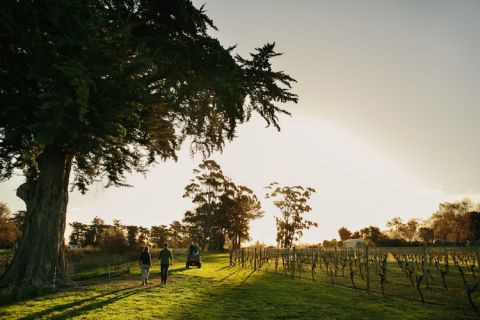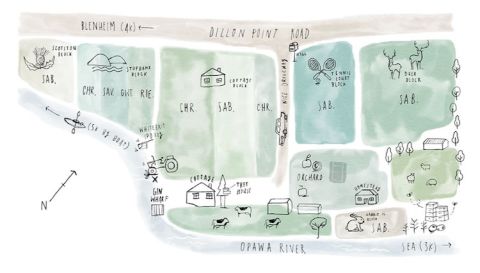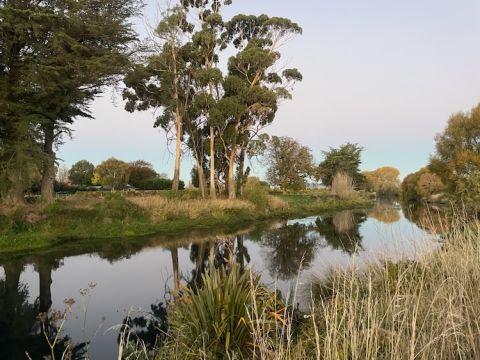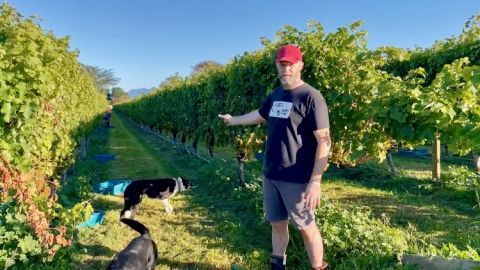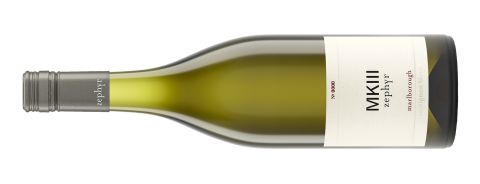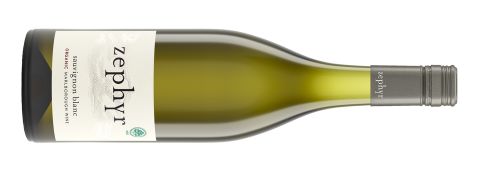Tasting the highly distinctive Zephyr MKIII Sauvignon Blanc in London earlier this month drew me to Ben Glover’s family estate in Marlborough, New Zealand. It’s a wine Glover describes as ‘disruptive’ and it grabbed my attention, standing out from the many more conventional Sauvignons shown that day.
The Glover name is well established in Marlborough. Ben’s parents settled on the family dairy farm when they got married but it seems milk was not going to be a strong enough liquid to engage the next generation of Glovers. It was the realisation that none of their four children wanted to get up at 5 am to milk cows that prompted Owen and Wendy Glover to swap their Friesian herd for vines. In 1988, they were the second to plant grapes in Dillons Point, the most easterly subregion in Marlborough’s Wairau Valley. (See this World Atlas of Wine map for the Wairau subregions.)
The Glovers currently farm 34 ha (84 acres), of which 18 ha are certified organic (BioGro) with more in conversion; all should be certified by 2025. Zephyr, the top tier of the three brands that come under the overarching company Coterie, was launched in 2017. It’s named after the prevailing gentle breeze that moderates temperatures in the vines, described by Ben Glover as ‘Marlborough’s best-kept secret’ because they get bright, sunny days without intense heat. But it’s not just about the breeze: they are also rather keen on the Ford Zephyr car, which has its own page on their site, and MKIII, the name of their less-conventional Sauvignon Blanc, is another allusion to this iconic family sedan. (Coterie also operates an organic custom-crush facility in what used to be the Seresin winery.)
Before quitting the wide, fast lane and returning home in 2016, Ben made his name in some of the bigger and most well-known companies in the region, including Wither Hills, Lindauer, Huntaway and Corbans, ending up as group winemaker for Accolade Wines, New Zealand, where he sourced fruit from all over the country for their various brands. Ben’s father Owen looks after the Glover vineyards, his wife Susie is a teacher but squeezes in time in the Zephyr ‘back room’ (her email sign-off is Girl Friday), and his younger brother Jack, currently general manager for Accolade Wines NZ, is a director. [Most recently, I am told, director of Hill Smith Family Estate in Australia.]
One unusual thing about Zephyr is that all the wines in the range are sourced from the named, family-owned vineyards shown in the sketch above. Just 3 km (less than 2 miles) from the sea, they have been made fertile by deposits from the Opawa River – still tidal as it flows past the estate – that forms the southern boundary, silty loam closer to the river with more clay loam moving north and away from the river. The vineyards are also sheltered from harsh weather from the south by the nearby Wither Hills.
Mk III Sauvignon Blanc is a wine that Glover has been ‘playing with’ since 2013. He explained in an email that he wanted to find a way ‘to allow Sauvignon Blanc to move away from the “greens” into the “yellows and whites” and deliver an exceptional palate sensation – rather than seduce with NZ Sauvignon aromatics first ... The intent is to make a white wine with superb versatility to all foods.’
The grapes come from the 1.5-ha (3.7-acre) Rabbit Island block, planted in 2006 and named after the rabbits that did so much damage to the growing tips when the vines were first planted – until Hogan the Wirehaired Pointer started to discourage them. It’s in conversion to organic farming and is unusual in that the rows run east–west not north–south because of the shape of the block. The north side of the rows gets far more sunshine and riper grapes than the south side, producing fruit that suits the style of wine Glover is looking for in MKIII.
Today the rabbits no longer eat the shoots but sheep are allowed to eat the leaves around the fruit zone just before veraison, exposing the fruit to the sun. (They have no interest in the berries since they are hard and green at that stage.) This is key to this style of wine: the more typical green flavours of the variety, derived from methoxypyrazines and from flavour precursors in the grapes (which the yeast turn into thiols, associated with grapefruit, box tree and passion-fruit flavours), are burnt off so that the grapes become yellow in colour and fruit profile and lower in malic acid.
Only the grapes on the riper north side of the rows go into this wine and are, unusually for Marlborough Sauvignon, hand-harvested and pressed as whole bunches, which also helps to reduce the pick-up of methoxypyrazines in the berries. (Fruit on the south side, which ripens about a week later, is picked by machine and goes into another wine.)
In the winery, the juice is deliberately exposed to oxygen, again to reduce methoxypyrazine- or thiol-derived green/herbaceous flavours in the finished wine. The juice is pressed straight to neutral barrels that are more than 10 years old and fermentation happens spontaneously. But it’s not just about the fruit flavours. Texture is also more important, as is the salty/savoury character that comes from the site and is enhanced by the winemaking. No additions are made until SO2 is added in preparation for bottling, when the wine is cold-stabilised and filtered (but not fined). Glover bottles only 500–800 cases of 12 of this wine.
As well as stone-fruit, citrus (clementine in particular) and salty aromas, I found layered complexity thanks to the smoky/flinty flavour that come from the effects of light reduction. There’s also an impression of fennel and coriander, two flavours that Glover picks out on the back label. It’s a long, mouth-watering wine that needs no residual sugar to balance the high acidity, not least because of the pithy, leesy texture that gives the wine so much presence in the mouth. As it warms up in the glass, it becomes even more creamy and rounded thanks to the use of non-intrusive oak and the time on the lees.
It’s a wine that needs time for its many sides to show as it opens up. For such a hand-crafted and distinctively delicious wine, it’s great value. It’s not white burgundy, and isn’t trying to be – there are still some recognisable Sauvignon Blanc flavours – but it has the same versatility with food that many a New Zealand Sauvignon lacks and is thus a very good, well-priced alternative.
This Mk III is unlikely to reach the US before May 2025 so I am also recommending the Zephyr Sauvignon Blanc 2023, which is made a little more conventionally – machine-harvested, inoculated with neutral yeast and fermented cool in tank, spending the winter on fine lees before being bottled without fining – but is still a long way from stereotypical New Zealand Sauvignon Blanc. Glover describes it as ‘slightly off-piste’.
He explains that he is not a fan of ‘thiol monsters’ (typically with intense flavours of grapefruit and/or passion fruit, box tree, sweaty notes and all that greenness) – a style that ‘blows your nostril hair off and immediately seduces you but after a glass you are left wondering, and questioning where the lovely back palate is with supple driven acidity, saline and mineral line – and often these styles of wine are very hard to match food to.’
These views are expressed through this lovely, persistent wine as well as in the MKIII. Even though it is less stylised than the MKIII and shows more of Sauvignon’s herbal flavours, as well as a hint of smoky grapefruit, it’s less extreme than the stereotype, somehow more ‘relaxed’ and has a suggestion of stony citrus and a slight textural grip; fresh, fragrant and crisp.
The fruit comes from the Scotston, Stopbank and Cottage blocks, all certified organic since 2020, where Chardonnay, Riesling and Gewürztraminer are also planted (see the vineyard plan above). It’s also well-priced, particularly in the US, though I think the MKIII is even better value considering the love lavished on it and the small quantity made.
Both wines benefit from the 2023 growing season, which Glover describes as very good, even and dry, with ‘superb balance’. The age of the vines (planted 1999–2008) means they benefit from these conditions, Glover suggests.
Zephyr Mk III Sauvignon Blanc 2023 is imported into the UK by Bancroft Wines and available from Hay Wines, Wine Republic, Bath Sixteen, The Stores in Frome, The Booze Shop West Yorkshire, The Booze Specialist and Just Wines. It is also available in New Zealand, Australia, Norway, Denmark, China and Germany. (It's also possible to buy directly from Bancroft by emailing orders@bancroftwines.com.)
Zephyr Sauvignon Blanc 2023 is imported into the US by Massanois Imports. It’s also available in Canada, Denmark, Germany, Norway, China and Hong Kong. (The 2023 will soon be on the market in the UK with an RRP of £20.95.)


